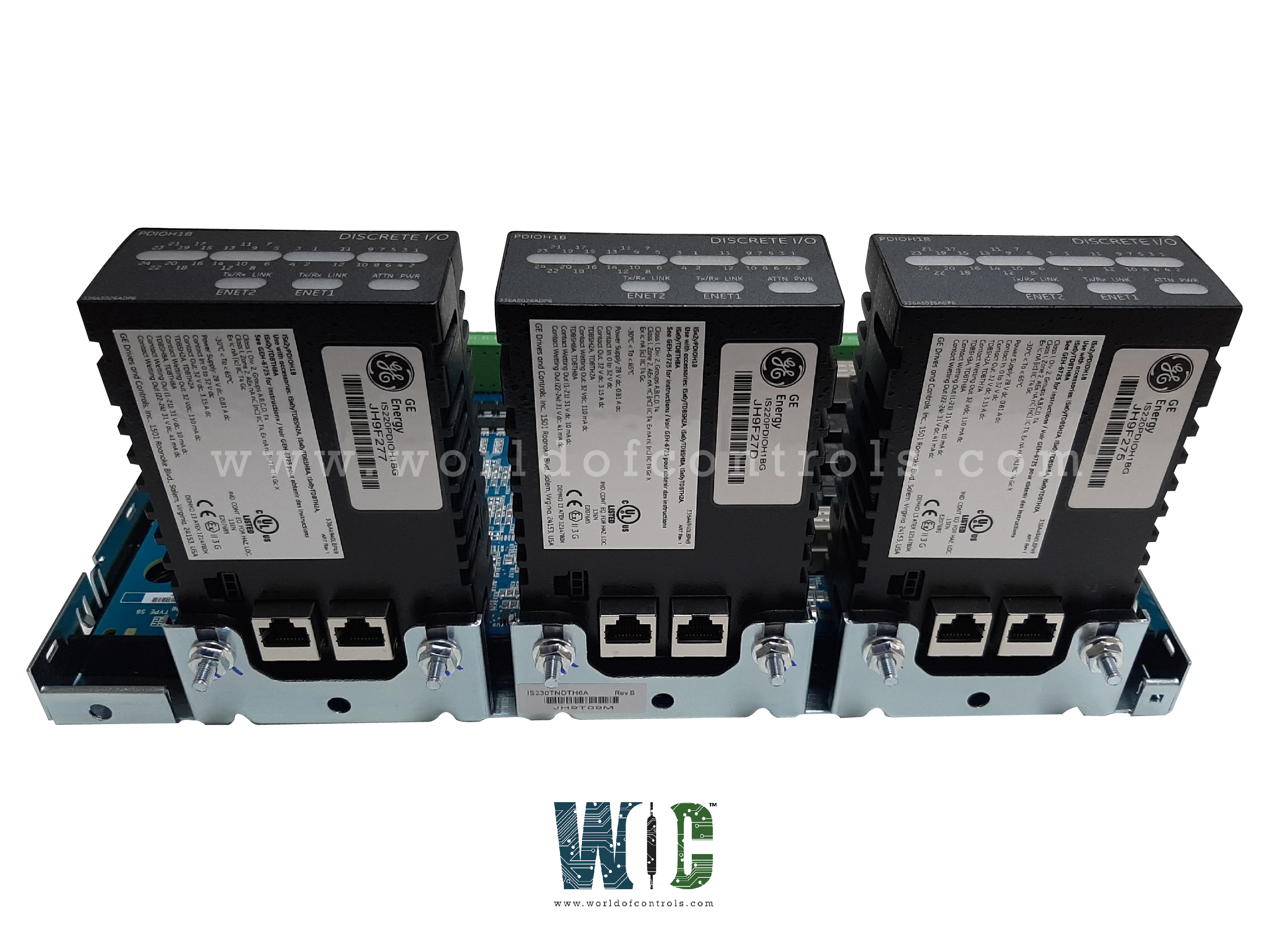SPECIFICATIONS
Part Number: IS230TNIDH2A
Manufacturer: General Electric
Series: Mark VIe
Technology: DINrail
Max response time off: 25 ms typical
Function: Discrete Input DIN-Rail Module
Availability: In Stock
Country of Manufacture: United States (USA)
Functional Description
IS230TNIDH2A is a Discrete Input DIN-Rail Module manufactured and designed by General Electric. It is a part of the Mark VIe Control System. The TNID provides the electrical interface between one or two I/O Ethernet networks and a discrete input terminal board. It serves as a bridge, ensuring smooth and efficient communication within a system.
Features
- Ethernet Connectivity: Interfaces with the system through dual RJ45 Ethernet connectors. This dual connection capability enhances network reliability and redundancy, ensuring continuous communication even if one network path fails.
- Power Input: The pack includes a three-pin power input, ensuring a stable power supply to maintain consistent operation and performance.
- Discrete Signal Input: Discrete signal input is managed through a DC-37 pin connector. This connector is designed to link directly with the associated terminal board connector, facilitating seamless signal transmission and reducing the risk of signal loss or interference.
- Visual Diagnostics: Equipped with indicator LEDs that provide visual diagnostics. These LEDs offer immediate visual feedback on the operational status and health of the device, aiding in quick identification and troubleshooting of any issues.
- Local Diagnostic Communications: For more detailed diagnostic analysis, it includes an infrared port that supports local diagnostic serial communications. This feature allows for in-depth diagnostics and troubleshooting, ensuring potential issues can be promptly and accurately addressed.
Processor Features
- High-Speed Processor with RAM and Flash Memory: Equipped with a high-speed processor, the board includes RAM and flash memory to support robust data processing and storage capabilities.
- Dual Ethernet Ports: Features two fully independent 10/100 Ethernet ports with connectors, enabling reliable network connectivity and data transfer.
- Hardware Watchdog Timer and Reset Circuit: Incorporates a hardware watchdog timer and reset circuit to enhance system stability and reliability by monitoring and resetting the processor if necessary.
- Local Ambient Temperature Sensor: Includes a local ambient temperature sensor to monitor and manage the operating temperature of the board, ensuring optimal performance.
- Infrared Serial Communications Port: Provides an infrared serial communications port for local diagnostic and communication purposes.
- Status-Indication LEDs: Equipped with status-indication LEDs to provide visual diagnostics and operational status at a glance.
- Electronic ID and ID Reading Capability: Contains an electronic ID and the capability to read IDs on other boards, facilitating identification and configuration within the system.
- Programmable Logic: Supports substantial programmable logic, aiding in the efficient operation and functionality of the acquisition board.
- Input Power Connector with Soft Start/Current Limiter: Features an input power connector with a soft start and current limiter to ensure smooth power-up and protect the board from power surges.
- Local Power Supplies: Includes local power supplies with sequencing and monitoring capabilities to manage and distribute power efficiently across the board.
Input Signals
- Second Stage Signal Conditioning and Level Shifting: The discrete input acquisition board performs the second stage of signal conditioning and level shifting, building on the initial signal conditioning provided by the terminal board. This ensures that the signals are appropriately conditioned for processing by the control logic.
- Comparator with Variable Threshold: Each input circuit includes a comparator with a variable threshold, allowing for precise adjustment and customization of signal sensitivity and detection.
- Opto-Coupler Isolation: Inputs are isolated from the control logic through opto-couplers, enhancing system safety and protecting the control logic from electrical noise and interference.
- Isolated Power Supply: An isolated power supply is used to power the input circuits, ensuring stable and reliable operation.
- Non-Isolated Inputs: While each input is isolated from the control logic, the inputs themselves are not isolated from each other. This design choice helps simplify the circuitry and reduce cost.
- Input Filtering and Hysteresis: Each of the twenty-four inputs features built-in filtering and hysteresis to improve signal stability and reduce the likelihood of false triggering.
- Status LEDs: Each input is equipped with a yellow status LED that indicates the state of the input. The LED lights up when the input is picked up and turns off when the input is dropped out, providing a clear visual indication of input status.
WOC is happy to assist you with any of your automation requirements. For pricing and availability on any parts and repairs contact us.
FREQUENTLY ASKED QUESTIONS
What is IS230TNIDH2A?
It is a discrete input DIN-Rail Module manufactured and designed by General Electric
What is signal conditioning and why is it important?
Signal conditioning involves modifying a signal to prepare it for the next stage of processing. It is crucial because it ensures that the input signals are in a suitable form for accurate and reliable processing by the control logic, thereby enhancing the overall system performance.
How does the comparator with a variable threshold work?
The comparator with a variable threshold allows for precise adjustment of the signal sensitivity. By setting the threshold level, you can control when the comparator triggers, ensuring that only signals meeting specific criteria are processed, thereby reducing noise and false triggering.
What is the role of the opto-coupler in the input circuits?
The opto-coupler isolates the input signals from the control logic. This isolation protects the control logic from electrical noise and interference, enhancing the system's safety and reliability.
